Classification of Fault | Geology Optional for UPSC PDF Download
| Table of contents |

|
| What is a fault? |

|
| Fault Structure |

|
| Fault Classifications |

|
| Faulting Geometry |

|
| Fault styles (types) |

|
| Faults and Forces |

|
| Effects of Faulting |

|
What is a fault?
- Rocks are very slowly, but continuously moving and changing shape. Under high temperature and pressure conditions common deep within Earth, rocks can bend and flow. In the cooler parts of Earth, rocks are colder and brittle and respond to large stresses by fracturing.
- A fault is a crack across which the rocks have been offset.
- They range in size from micrometers to thousands of kilometers in length and tens of kilometers in depth, but they are generally much thinner than they are long or deep.
- In addition to variation in size and orientation, different faults can accommodate different styles of rock deformation, such as compression and extension.
- Not all faults intersect Earth’s surface, and most earthquakes do not rupture the surface. When a fault does intersect the surface, objects may be offset or the ground may get cracked, or raised, or lowered. We call a rupture of the surface by a fault a fault scarp and identifying scarps is an important task for assessing the seismic hazards in any region.
Fault Structure
- Although the number of observations of deep fault structure is small, the available exposed faults provide some information on the deep structure of a fault.
- A fault “zone” consists of several smaller regions defined by the style and amount of deformation within them.
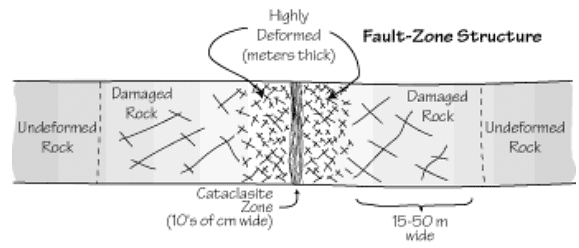
- Structure of an exposed section of a vertical strike-slip fault zone (after Chester et al., Journal of Geophysical Research, 1993).
- The centre of the fault is the most deformed and is where most of the offset or slip between the surrounding rock occurs.
- The region can be quite small, about as wide as a pencil is long, and it is identified by the finely ground rocks called cataclasite ( the ground-up material found closer to the surface, gouge).
- From all the slipping and grinding, the gouge is composed of very fine-grained material that resembles clay.
- Surrounding the central zone is a region several meters across that contains abundant fractures.
- Outside that region is another that contains distinguishable fractures, but is much less dense than the preceding region. Last is the competent “host” rock that marks the end of the fault zone.
Fault Classifications
Active, Inactive, and Reactivated Faults
- Active faults are structures along which one expects displacement to occur. By definition, since a shallow earthquake is a process that produces displacement across a fault, all shallow earthquakes occur on active faults.
- Inactive faults are structures that one can identify, but which do not have earthquakes. Because of the complexity of earthquake activity, judging a fault to be inactive can be tricky, but often we can measure the last time substantial offset occurred across a fault. If a fault has been inactive for millions of years, it’s certainly safe to call it inactive. However, some faults only have large earthquakes once in thousands of years, and we need to evaluate carefully their hazard potential.
- Reactivated faults form when movement along formerly inactive faults can help to alleviate strain within the crust or upper mantle. Deformation in the New Madrid seismic zone in the central United States is a good example of fault reactivation. Structures formed about 500 Ma ago are responding to new forces and relieving strain in the mid-continent.
Faulting Geometry
Faulting is a complex process and the variety of faults that exist is large. We will consider a simplified but general fault classification based on the geometry of faulting, which we describe by specifying three angular measurements: dip, strike, and slip.
Dip:
- On Earth, faults take on a range of orientations from vertical to horizontal.
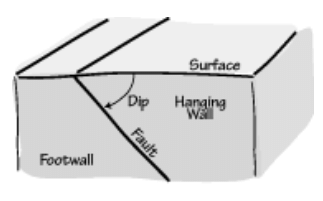
- The dip is the angle that describes the steepness of the fault surface. T
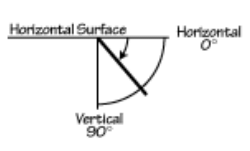
- his angle is measured from Earth’s surface, or a plane parallel to Earth’s surface.
- The dip of a horizontal fault is zero (usually specified in degrees: 0°), and the dip of a vertical fault is 90°.
- Some old mining terms are used to label the rock “blocks” above and below a fault. If you were tunnelling through a fault, the material beneath the fault would be by your feet, the other material would be hanging above your head. The material resting on the fault is called the hanging wall, and the material beneath the fault is called the footwall.
Strike:
- The strike is an angle used to specify the orientation of the fault and measured clockwise from north.
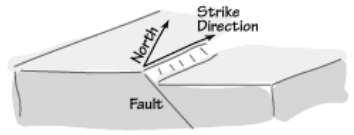
- For example, a strike of 0° or 180° indicates a fault that is oriented in a north-south direction, and 90° or 270° indicates an east-west oriented structure.
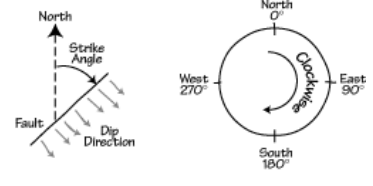
- To remove the ambiguity, always specify the strike such that when you “look” in the strike direction, the fault dips to your right.
- If the fault is perfectly vertical you have to describe the situation as a special case.
- If a fault curves, the strike varies along the fault, but this seldom causes a communication problem if you are careful to specify the location (such as latitude and longitude) of the measurement.
Slip:
- Dip and strike describe the orientation of the fault, we also have to describe the direction of motion across the fault.
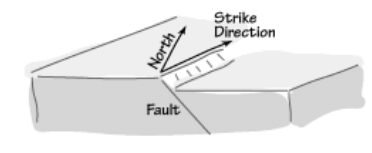
- That is, which way did one side of the fault move with respect to the other?
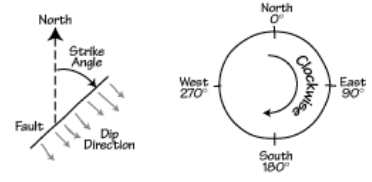
- The parameter that describes this motion is called the slip.
- The slip has two components, a “magnitude” which tells us how far the rocks moved, and a direction (it’s a vector).
- We usually specify the magnitude and direction separately.
- The magnitude of slip is simply how far the two sides of the fault moved relative to one another; it’s a distance usually a few centimetres for small earthquakes and meters for large events.
- The direction of slip is measured on the fault surface, and like the strike and dip, it is specified as an angle.
- Specifically, the slip direction is the direction which the hanging wall moved relative to the footwall.
- If the hanging wall moves to the right, the slip direction is 0°; if it moves up, the slip angle is 90°, if it moves to the left, the slip angle is 180°, and if it moves down, the slip angle is 270° or -90°.
Fault styles (types)
Hanging wall movement determines the geometric classification of faulting. One can distinguish between “dip-slip” and “strike-slip” hanging-wall movements.
Dip slip- Dip-slip – movement occurs when the hanging wall moves predominantly up or down relative to the footwall.
- If the motion is down, the fault is called a normal fault, if the movement is up, the fault is called a reverse fault.
- The downward movement is “normal” because we normally would expect the hanging wall to slide downward along the foot wall because of the pull of gravity.
- Moving the hanging wall up an inclined fault requires work to overcome friction on the fault and the downward pull of gravity.
Strike-slip–When the hanging wall moves horizontally, it’s a strike-slip
- If the hanging wall moves to the left, the earthquake is called right-lateral, if it moves to the right, it’s called a left-lateral fault.
- The way to keep these terms straight is to imagine that you are standing on one side of the fault and an earthquake occurs.
- If objects on the other side of the fault move to your left, it’s a left-lateral fault, if they move to your right, it’s a right-lateral fault.
- Oblique slip- When the hanging wall motion is neither dominantly vertical nor horizontal, the motion is called oblique slip. Although oblique faulting isn’t unusual, it is less common than the normal, reverse, and strike-slip movement.
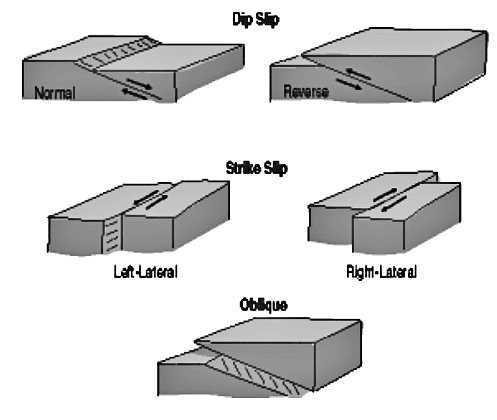
Faults and Forces
- The style of faulting is an indicator of rock deformation and reflects the type of forces pushing or pulling on the region.
- Near Earth’s surface, the orientation of these forces are usually oriented such that one is vertical and the other two are horizontal. The precise direction of the horizontal forces varies from place to place as does the size of each force.
- The style of faulting that is a reflection of the relative size of the different forces – in particular is the relative size of the vertical to the horizontal forces.
- There are three cases to consider, the vertical force can be the smallest, the largest, or the intermediate (neither smallest or largest). If the vertical force is the largest, we get normal faulting, if it is the smallest, we get reverse faulting. When the vertical force is the intermediate force, we get strike-slip faulting.
- Normal faulting is indicative of a region that is stretching, and on the continents, normal faulting usually occurs in regions with relatively high elevation such as plateaus.
- Reverse faulting reflects compressive forces squeezing a region and they are common in uplifting mountain ranges and along the coast of many regions bordering the Pacific Ocean. The largest earthquakes are generally low-angle (shallow dipping) reverse faults associated with “subduction” plate boundaries.
- Strike-slip faulting indicates neither extension nor compression, but identifies regions where rocks are sliding past each other. The San Andreas fault system is a famous example of strike-slip deformation – part of coastal California is sliding to the northwest relative to the rest of North America – Los Angeles is slowly moving towards San Francisco.
- As one might expect, the distribution of faulting styles is not random, but varies systematically across Earth and was one of the most important observations in constructing the plate tectonic model which explains so much of what we observe happening in the shallow part of Earth.
Effects of Faulting
Faulting is essentially a process of rupturing and displacement along the plane of rupture.
Its effect may involve:
- Changes in the elevation of the ground,
- Omission of some strata where they are normally expected,
- Repetition of some strata in a given direction against the normal order of superposition, and, Displacements and shifts in the continuity of the same rocks in certain regions.
- Faults of some magnitude, need a lot of fieldwork involving extensive mapping on the exposed outcrops and also geophysical measurements for establishing contacts of different types of rocks. It is only from the study of geological maps that the existence of faults in the first place and their effects on the rocks may be established with some certainty.
- Further, the features produced due to faulting on the ground are subject to modifications by the subaerial processes of weathering and erosion with the passage of time. Hence what we describe today as the effects of faults may be, in fact, the effects of faults as modified by erosion and weathering.
Effect of Faulting On Topography:
- One of the main effects of the faults on topography is that they very often result in the development of distinct types of steep slopes which are aptly called fault scarps. Three types of fault associated scarps are often recognized– fault scarps, fault-line scarps and composite-fault scarps.
- In fault scarps, the relief is developed due to downward slip along the fault surface.
- In the fault-line scarps, however, the slope relief is produced due to process of unequal erosion along the fault line with the passage of time.
- When a given slope is believed to be the result of both of these processes, the scarp is of a composite type.
- Besides fault scarps, faulting is also responsible for development of Block Mountains like horsts and deep elongated valleys called the grabens and the rift valleys.
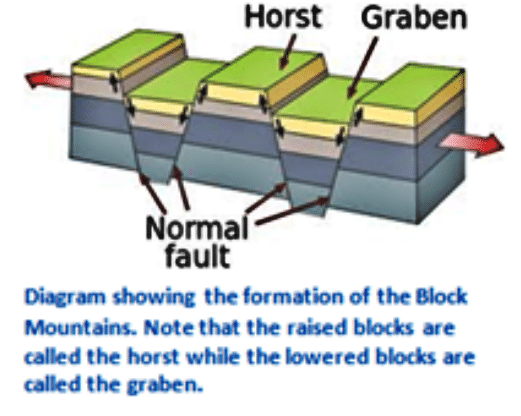
- Faults are also known to cause deflection in the course of streams.
- Similarly, in certain regions, a number of springs may come into being along a fault line that happens to cut across an aquifer. These aligned springs may often prove to be an important evidence of faulting in the region.
|
64 videos|135 docs
|















